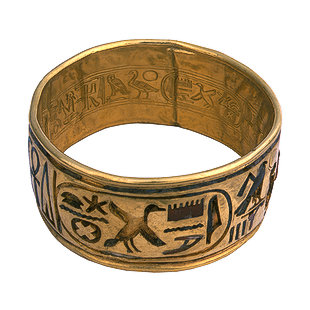Ornaments, which are designed to what Lizzie its metalwork jewelry or stones, are the most important work of the goldsmith at the Egyptian pharaohs, the manufacture of gold or silver, decorated with some of the stones in some cases. He was known Bijadthm craft language and their mastery of it. These ornaments are attached to the chest, including what is placed in the hands or fingers, and it is placed on the leg. And attached elsewhere in the body such as the ears or nose or on the forehead, and some of which sweetened by the animal or valuables at home.
It is famous Andalmsrien jewelry, necklace. Made of gold or silver in most cases, may be linked from stones or bones or beads to each other.

Treasures of Tutankhamun - the sun god pendant - Trumpet of Tutankhamun



Pharaonic civilization has reached a substantial degree of prosperity and progress both in science and politics, art and civilization, progress in all areas, and areas of this development, one of the ornaments the technical aspects of 0
Jewelry played different roles in Egypt. In addition to the attraction of human nature for things of beauty; the jewelry had been important for religious and magical in the world of the ancient Egyptian, to protect the wearer from bad.

The ancient Egyptians started making jewelry since the modern Badari and Naqada in prehistoric times from the simple materials. Such as: branches of plants and shells, beads, stones or hard-bone, and these were organized in threads of flax or cow hair. To give some sparkle stones, ancient Egyptians began painting in the glass materials. And acquired skill of making jewelry out of semi-precious stones and different metals such as gold and silver since the time of the First Dynasty. The gold industry reached its peak in the Middle Kingdom, when Egyptians mastered the technical methods and accuracy in making pieces of jewelry. The gold industry has flourished in the era of the modern state, in an unprecedented way because of the systematic mining missions to the Eastern Desert and Nubia to extract metals. It was the metal handle and feed all types of semi-precious stones, known in Egypt, such as vaccination of gold and silver, agate and turquoise.


The jewelry used in daily life through the ages from ancient Egyptian history into Romanian. The ancient Egyptians were keen on keeping a large number of pieces of jewelry inside the tombs, and these were placed on the body of the deceased. We have found large numbers of pieces of jewelry graves, including wreaths and crowns or collars and install Alharatabiey nickname and ornaments of various types of plastic: such as rosettes, small gold hoops and bands of simple jewelry. There were also different types of belts; such as waist belts and belts hanging down, vertical bars, and also the types of jewelry earrings, bracelets, anklets, rings, contracts, and vest.

The chest type of jewelry that never appeared in any of the other civilizations and only appearance on the ancient Egyptian civilization, and were worn around the chest. It was usually made of gold, or metal faint gold and even if made of cheap material, it was painted yellow to take the appearance of gold. It is still wearing the vest of gold known in the Egyptian countryside, and the chest taken in this case a different name; is "Alcardan." The dream of every girl to wear a rural Kordan gold boasts it.
Beautification ornaments not limited to women, men in Egypt were using ornaments as well; until the Roman era, but since the advent of Christianity to the country and turned many people to the new religion, the ornaments and manifestations of extravagance and luxury and has become less common; and was replaced by manifestations of piety and religion. Own LinuxFocus ornaments of cheaper materials bearing Christian symbols; such as the cross and doves and the sign of life "Ankh" hieroglyphics; instead of talisman and amulets that were used before. After the advent of Islam to Egypt, wife of men, especially gold jewelery adornment; and continue to use alternative materials silver.
Have been found on various types of sticks that were used Kaasi ceremonies or Mzbat wands or sticks or crutches or brackets. It was the sticks are usually made of wood, and sometimes blurred the Browse or gold and fed semi-precious stones.
Bracelets from the Tomb of King Jr.
Bracelet of Queen Ahhotep
Bracelet of King Psusennes first
A piece of jewelry found in the tomb of Tutankhamun
Wreath of Princess Knomit
Mantra in the form of an eagle
A group of jewelry Pharaonic *
Pharaonic jewelry. #PH1005
Pharaonic jewelry. # PH1006
Maliq series by a statue of the Goddess Isis
golden belt
A belt decorated with gold beaded
Earring Pendants
Fashion permission of King Seti II
Ring of Psusennes
A pair of bracelets for the first King Psusennes
A pair of earrings of King Ramses atheist ten
Gold chains, Princess Khnumit
Cylindrical bracelet of Psusennes first
Bracelet of Queen Ahhotep
Linking around the neck, hanging on the chest. That the necklace in the language of the general term called many things. It was put
Bangle from cosmetics as well. Has been used by the people of Egypt established by the women in her hands. That some of the combatants were using the bracelets, and boast in the war.
The earring, ear ornaments, it is attached Bahmp permission of gold or diamonds

